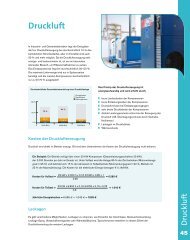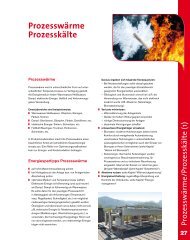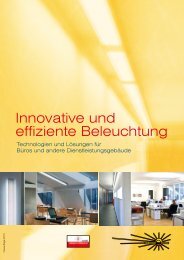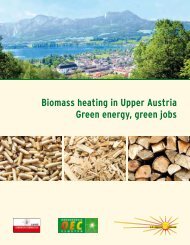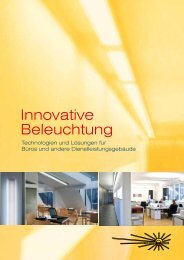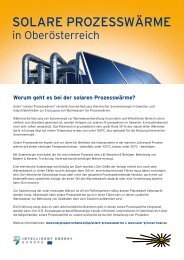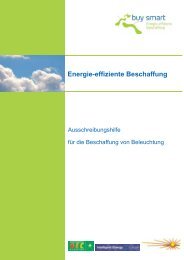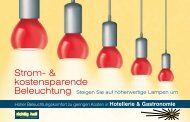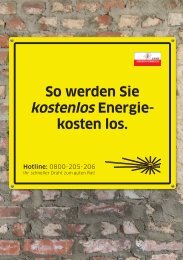Absorption chiller driven by bio-heat
Absorption chiller driven by bio-heat
Absorption chiller driven by bio-heat
Create successful ePaper yourself
Turn your PDF publications into a flip-book with our unique Google optimized e-Paper software.
RTD Project Identification<br />
RTD Project Name: <strong>Absorption</strong> <strong>chiller</strong> <strong>driven</strong> <strong>by</strong><br />
<strong>bio</strong>-<strong>heat</strong><br />
Description of technology has<br />
Biomass boiler and absorption <strong>chiller</strong> for<br />
small-scale <strong>heat</strong>ing/cooling applications<br />
Ab- or adsorption <strong>chiller</strong>s have just been<br />
available with rather large cooling capacities,<br />
most often beyond 100 kW, which made them<br />
unsuitable for smale scale applications such as<br />
airconditioning in office or residential buildings.<br />
Only recently smaller engines with a capacity of<br />
10-20 kW have emerged and even smaller ones<br />
(2-5 kW) are under way.<br />
The main benefit of a thermally-<strong>driven</strong> ab- or<br />
adsorption <strong>chiller</strong> is the lower electricity<br />
consumption compared to an electrical<br />
compression <strong>chiller</strong>. By using renewable <strong>heat</strong><br />
(e.g. solar <strong>heat</strong> or <strong>heat</strong> produced <strong>by</strong> a <strong>bio</strong>mass<br />
boiler) the whole process is nearly CO2 neutral.<br />
In Stigliano (Matera province, Basilicata Region,<br />
Italy) the installation of a joint <strong>heat</strong>ing and<br />
cooling <strong>bio</strong>mass system will be completed <strong>by</strong><br />
the end of 2007. The system is installed in the<br />
Centro Eccellenza Bioenergia (see Fig. 1),<br />
which is an office building with a size of<br />
1.000 m 3 and acts as a regional “Formative<br />
Centre for Bioenergy Applications”. The<br />
production of "cold" is done <strong>by</strong> a single stage<br />
lithium bromide (LiBr) absorption <strong>chiller</strong> <strong>driven</strong><br />
<strong>by</strong> hot water produced <strong>by</strong> a <strong>bio</strong>mass boiler. The<br />
<strong>bio</strong>mass boiler is used for hot water producrtion,<br />
for space <strong>heat</strong>ing in winter and for<br />
airconditioning in summer.<br />
The Li-Br cycle was prefered to the ammonia<br />
cycle due to the possibility of using lower<br />
process temperatures (90 C°), which can also<br />
be achieved <strong>by</strong> commercial <strong>bio</strong>mass water<br />
ProEcoPolyNet<br />
Best practice Sheet<br />
”<strong>Absorption</strong> <strong>chiller</strong> <strong>driven</strong> <strong>by</strong> <strong>bio</strong>-<strong>heat</strong>”<br />
boilers. The ammonia cycle requires diathermic<br />
oil boilers or high pressure steam with<br />
temperatures up to 300 °C.<br />
Fig. 1 The Centro Eccellenza Bioenergia<br />
The performance of the plant will be compared<br />
to a reference system (electrical compression<br />
<strong>chiller</strong>) in respect of economical, environmental<br />
and social aspects. Process monitoring of<br />
energy balances and <strong>bio</strong>fuel costs will be carried<br />
out to evaluate the installation.<br />
Operating principle has<br />
The absorption cycle<br />
The absorption cycle uses a <strong>heat</strong>-<strong>driven</strong><br />
concentration difference to move refrigerant<br />
vapors (usually water) from the evaporator to<br />
the condenser.<br />
As shown in Fig. 2 refrigerant (mostly water) is<br />
evaporating in the evaporator. Heat is<br />
consumed and this causes the chilling effect.<br />
The water vapor is absorbed <strong>by</strong> the absorber<br />
(concentrated LiBr solution) due to its<br />
hygroscopic characteristics. The more diluted<br />
solution is then pumped to the concentrator at a<br />
higher pressure where <strong>heat</strong> is applied (using<br />
steam or hot water) to drive off the water and<br />
there<strong>by</strong> re-concentrate the lithium bromide. The
water <strong>driven</strong> off <strong>by</strong> this <strong>heat</strong> input step is then<br />
condensed (using cooling tower water),<br />
collected and transported to the evaporator to<br />
complete the cycle. The absorption <strong>chiller</strong> must<br />
operate at very low pressures (about l/l00 th of<br />
normal atmospheric pressure) for the water to<br />
vaporize at a cold enough temperature.<br />
The absorbent is the material that is used to<br />
maintain the concentration difference in the<br />
machine. Most commercial absorption <strong>chiller</strong>s<br />
use LiBr. LiBr has a very high affinity for water,<br />
is relatively inexpensive and non-toxic.<br />
However, it can be highly corrosive and disposal<br />
is closely controlled. Water used as refrigerant is<br />
extremely low cost and safety simply isn't an<br />
issue.<br />
Technical characteristics of<br />
installation<br />
The proposed system will be constituted <strong>by</strong><br />
three main components:<br />
• <strong>bio</strong>mass high efficiency water boiler (see<br />
Fig. 3) with a thermal output capacity of<br />
55 kW (<strong>by</strong> Froeling)<br />
• absorption <strong>chiller</strong> (see Fig. 4) with a cooling<br />
capacity of 35 kW (<strong>by</strong> Maya) and a COP<br />
(Coefficient of Performance) of 0,7.<br />
• cooling tower<br />
A simplified scheme of the installation is shown<br />
in Fig. 5.<br />
The plant is supposed to operate for 2.000<br />
hours/year during the winter season. During the<br />
summer and the intermediate seasons other<br />
2.000 hours/year are foreseen (airconditioning<br />
and domestic hot water production).<br />
It is estimated, that this <strong>bio</strong>mass project<br />
contributes to climate protection with CO2savings<br />
of 110 t per year.<br />
Location and use<br />
Fig. 2 The basic operation cycle of the single stage absorption <strong>chiller</strong><br />
This LiBr-absorption <strong>chiller</strong> in combination with a<br />
<strong>bio</strong>mass boiler is intended to be used for<br />
airconditioning of residential and office buildings.<br />
In this case the <strong>chiller</strong> was installed in an office<br />
building with a size of 1000 m 3 .
State of Development/Market<br />
implementation<br />
Small scale absorption <strong>chiller</strong>s <strong>driven</strong> <strong>by</strong> <strong>bio</strong><strong>heat</strong>,<br />
which can compete with modern<br />
electrical compression <strong>chiller</strong>s, are still in the<br />
phase of field testing. Practical guidelines for<br />
the construction, design and dimensioning of<br />
such absorption <strong>chiller</strong>s are still rare. A greater<br />
number of evaluated demonstration plants<br />
might help to overcome this lack of experience.<br />
Benefits and obstacles<br />
Benefits<br />
• <strong>Absorption</strong> <strong>chiller</strong>s provide the possibility to<br />
produce "cold" <strong>by</strong> the usage of renewable<br />
energy (<strong>bio</strong>mass or solar energy).<br />
• The electricity grids – especially in the<br />
warmer, southern parts of Europe – are not<br />
designed for peak loads nowadays<br />
encountered on hot summer days. This<br />
might results in a instable grid and even in<br />
electrical power outages. The replacement<br />
of electrically <strong>driven</strong> compression <strong>chiller</strong>s <strong>by</strong><br />
thermally <strong>driven</strong> absorption <strong>chiller</strong>s could<br />
reduce the huge amount of electricity used<br />
for air-conditioning and help to reduce the<br />
risk of a national electric power breakdown.<br />
• <strong>Absorption</strong> <strong>chiller</strong>s do not use refrigerants<br />
with ozone-depleting potential or global<br />
warming potential.<br />
Fig. 3 The <strong>bio</strong>mass boiler<br />
Obstacles<br />
• The upfront investment costs for absorption<br />
<strong>chiller</strong>s are still higher than for conventional<br />
electrical compression <strong>chiller</strong>s. Simulations<br />
for various office buildings have shown that<br />
the upfront investment costs for absorption<br />
systems are still about 2 up to 2,5 times<br />
higher than for conventional systems. Even<br />
assuming very low fuel prices absorption<br />
<strong>chiller</strong>s are mostly not competitive if no<br />
subsidies are granted.<br />
Fig. 4 The absorption <strong>chiller</strong><br />
Capital investment and maintenance<br />
costs<br />
► Capital investment<br />
Capital costs are put at € 65.000. The<br />
additional charges compared to a conventional<br />
electrical compression <strong>chiller</strong> are around<br />
€ 30.000. Subsidies of € 35.000 were granted.<br />
► Fuel costs<br />
Biofuel costs: 120 €/toe<br />
(wood chips with a moisture content of 35%,<br />
complying with ÖNORM M 7133)<br />
► Fuel consumption (estimation)<br />
Overall fuel consumption: 60 toe/year<br />
Fuel consumption for cooling: 20 toe/year
► Cost-Benefits features (estimation)<br />
Operating costs of a conventional vapour<br />
compression <strong>chiller</strong> (reference system)<br />
• kWhel x working hours x working factor<br />
• Electric energy fare: 0,14 €/ kWhel<br />
• Yearly energy cost: € 7.000<br />
Contact and further information<br />
Dr. Franco Pesce<br />
Agricultural Dept.-Basilicata Region<br />
Potenza (PZ)<br />
Italy<br />
frpesce@regione.basilicata.it<br />
Operating costs of the absorption <strong>chiller</strong> <strong>driven</strong><br />
<strong>by</strong> <strong>bio</strong>mass<br />
• kWhth x working hours x working factor<br />
• Biomass cost: 0,02 €/kWhth<br />
• Yearly energy cost: € 1.000<br />
Additional charges PAY- BACK time<br />
• 6 years<br />
Fig. 5 Simplified scheme of the plant (<strong>heat</strong> source (caldaia), absorption <strong>chiller</strong> (macchina ad assorbimento),<br />
cooling tower (torre di raffreddamento), storage (batteria)<br />
ITABIA – Italian Biomass Association<br />
Andrea Scarpini - Vice President<br />
Via Acireale 19, 00181 ROMA<br />
Tel 06 7021118 – fax 06 70304833<br />
E-mail: itabia@mclink.it, www.itabia.it<br />
2007-12-16<br />
Date of release of this Best Practice Sheet



